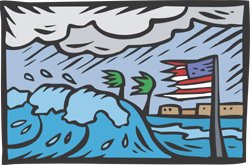http://www.timesonline.co.uk/article/0,,2-2066926,00.html
The frozen continent is shedding about 36 cubic miles (152 cu km) of ice every year — enough to supply Los Angeles with water for 36 years — according to research suggesting that sea levels could rise more rapidly than predicted.
Scientists had expected that over the coming century global warming would increase the size of the Antarctic ice sheet, as higher temperatures brought increased snowfall, but the new data suggest that it is losing mass.
The findings, from the satellites of the Gravity Recovery and Climate Experiment (Grace) begun in 2002, are a concern because the ice sheet would increase sea levels by as much as 45m (150ft) were it all released. The West Antarctic ice sheet, where the bulk of the melting is taking place, holds water that would raise the sea level by more than 6m (20ft). The East Antarctic sheet, which is eight times larger, appears to be more stable.
The results indicate that rising temperatures are having a major impact on both ice caps: two weeks ago, a separate study found that the amount of ice dumped into the ocean by glaciers in Greenland had doubled over five years.











